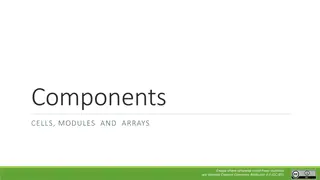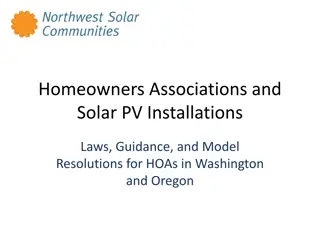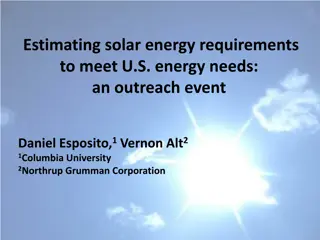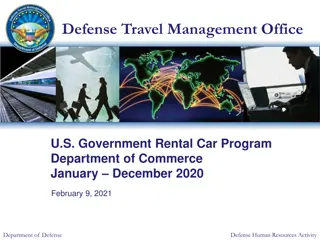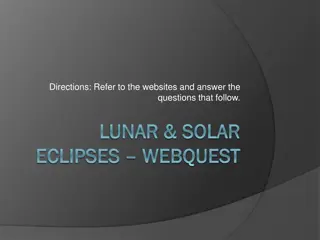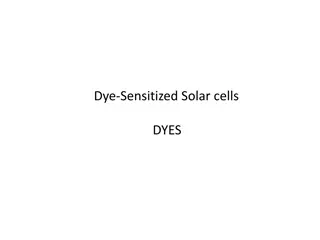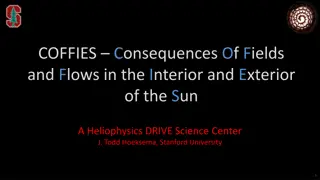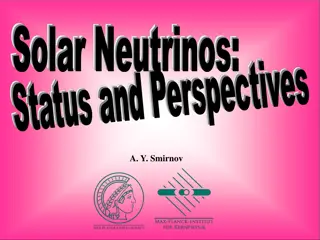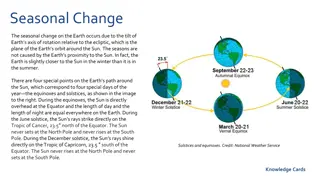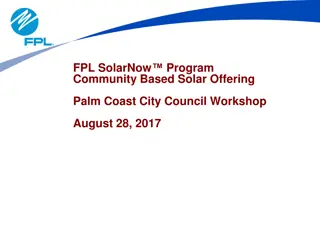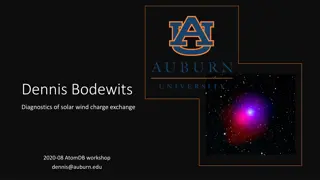Solar Car Challenge 2020 Rules and Updates
The Solar Car Challenge 2020 entails rules for participants, periodic updates, important dates, registration requirements, and guidelines for designing solar cars. Teams must adhere to documentation, design standards, and submission deadlines to ensure compliance with event regulations.
Download Presentation

Please find below an Image/Link to download the presentation.
The content on the website is provided AS IS for your information and personal use only. It may not be sold, licensed, or shared on other websites without obtaining consent from the author. Download presentation by click this link. If you encounter any issues during the download, it is possible that the publisher has removed the file from their server.
E N D
Presentation Transcript
RULES FOR THE 2020 SOLAR CAR CHALLENGE
EVENT UPDATES The Rules are periodically clarified or amended to meet the needs of the specific race. Rule 29 requires solar car teams to make periodic reviews of these updates to stay up- to-date.
Rules Overview Do: Keep copies of rules throughout workshop Following engineering lifecycle: requirements, design, implementation, verification Don t: Just read once or all in one sitting Look at another car s design and assume it complies with rules (grandfather; waivers)
Important Dates September 1 to January 31 - Intent-to-Race Form This notifies Race Officials that you plan to participate in the 2019 Solar Car Challenge, and places your team on a mailing list to receive Event Updates and other mailings. This form must be filed to file a registration document. March 1st- File Registration Document This includes full documentation about your solar car project as required by Rule 3.6, and your team s registration fee.
Registration Sections 1 3: Purpose, Administration, Entries and Registrations Registration Documents and Registration Fee requirement March 1st: (1) Detailed CAD drawings showing mechanical structure, including crush zones. Crush zones must be clearly labeled. (2) Detailed schematic / wiring diagram showing electrical system. (3) Digital team photo [emailed] (4) Manufacturer s data sheets for batteries showing type & capacity (5) Manufacturer s data sheets for solar array, including list price (6) Manufacturer s data sheets for motor and motor controller (7) Manufacturer s data sheets for array and battery cutoff switches (8) Manufacturer s data sheets for main fuses (9) Manufacturer s data sheets for wheels and brakes Digital and hard copies required by March 1st. [Rule 3.6]
Rule 3.8 Design of Solar Car It is the intent of the event that the solar cars be designed and constructed by high school students on the solar car team. No portion of another vehicle s frame may be reused in a solar car unless the team re- engineers/modifies the frame to fit the team s solar car design or to install separate off-the- shelf components.
Rule 3.9 - Scrapbook Scrapbook must be shown to Check-In to Race. Scrapbook must show history of the team building the solar car, including team engineering decision-making. Scrapbook will show team photos, design & planning, CAD drawings, fundraising, testing. Digital copy of scrapbook due June 1st.
Rule 3.10 Oral Presentations Up to 20 laps not available for oral presentations. Presentation show discuss the teams overall planning, including engineering decisions. Teams have a strict 8 minutes to give their presentation. Judges will now give feedback per Oral Presentation Guidelines
Qualifier Qualifier for the 2020 Race will include: (1) 3-Day Scrutineering (2) Stage One First Day of Racing The top teams in each Solar Car Challenge Racing Division will move on to the three-day Stage Two of racing. [Approximately 25 teams] The winner in each division will be the team that accumulates the most laps in Stare 1 and 2. All teams will receive an Official Race Ranking
Section 10: DIVISIONS Classic Division: No hub motors; lead-acid batteries; solar modules at 20% efficient Advanced Classic Division: 3 or more years in classic with same basic vehicle structure and major components Advanced Division: Hub motors; prefabricated solar car molds; advanced battery chemistries Electric-Solar Powered Car Division: Solar cells on charging station; Classic Division technology; 2 x 2kWh battery packs Cruiser Division: Seating for four; totally enclosed; solar array integrated into the skin of the vehicle; workable trunk
Section 5: SOLAR CAR REGULATIONS 5.1 Dimensions Length = 5m, Height = 1.6m, Width = 1.8m 5.1.2 Stability [Tilt Test] 5.1.3 Body of Vehicle windshields required, but body is not required unless judges determine that driving without a body would be unsafe. A belly pan is required. Crush Zones drawings must include vertical and horizontal dimensions and dimensions of Roll Bar. [Rule 3.6] 5.2 Structure teams must be able to demonstrate specific, adequate crush zones. 5.2.1 Roll Cage welded to frame (1.9cm OD, 5cm clearance) 5.2.2 - Crush zones (15cm from driver in all directions) 5.2.3 Roll Bar welded to frame 5cm above driver s head (5cm OD) and must be construction of one continuous piece of metal.
Section 5.4 - ELECTRICAL [5.4] Batteries: 5 kWh max at 20 hr discharge rate; terminals must have locking washers. [5.4.2] Main Fuse: 125% of expected peak current, separate enclosure; Rated as appropriate for DC voltage; Made by Copper Bussman (~$20) ANN = Very Fast Acting [5.4.3] Enclosures: Rigid, must have forced-air ventilation; no venting into driver s compartment [5.4.4] Supplemental Batteries: Powers all devices other than propulsion; must have low battery warning system [5.4.5] Disconnect Switches: Must be push-off; 2 each of motor and array disconnects. Relay/contactor in 2021!
5.5 Electrical System Grounding no grounding to frame 5.7 Wire, Insulation, Connections properly sized wire (use wire table; sized to continuous system current) *For 2021, no HV wire in driver s compartment* 5.9 Visibility
5.10 Braking test at Low Speed and High Speed 5.11 Steering and turning radius [15-meters] 5.12 Warning Systems Turn Signals, Hazards, and Horn Stop red lights; Turn & Hazards amber lights 5.13 Driver Safety (a) Safety Belt 5 point lap & shoulder belt [Grade 8 bolts] attached to frame of solar car (b-c) Impact Protection (body shells attached) (d) Windshield must protect driver s entire face (e) Cockpit egress in 15 seconds (f) Fire extinguishers [Appropriate to battery type] (g) Liquid container properly secured to the vehicle (h) Belly pan (i) Forced Air Circulation (j) Driver seat provides neck support & is bolted to frame (k) Battery spill kit (baking soda) (l) Closed toe shoes/hats (m) Protective Eyewear in garage area
5.14 Throttle 5.15 Covers & Shields 5.16 Electrical shock hazards HV signs; properly insulated 5.17 - Radios 6 Nature of the Event Closed Track Race Teams accumulate laps driving around Texas Motor Speedway. Partial laps do not count. The team achieving the most laps over the four days of racing will be declared the winner. 6.1 Elapsed time 6.2 Taking part in special events and Challenge Event 6.3 Items provided by Race 6.4 Items provided by participants 6.5 Trailering provisions 6.8 Charging 6.9 Impound 6.11 Attire full brim hats, closed-toe shoes, jeans/shorts 7 Scrutineering 7.8 Required use of welding screen 8 Registration 8.3 Registration Fee 8.5 Team guests must comply with race rules
Sections 9, 11-21: How the race is run; read to understand what a day is like 19. Support vehicles teams must have a support vehicle with trailer so that they can go out onto the track to pick up the solar car in the event of a break down. 23. Judging responsibilities of judges; duty to judges 24. Penalties 25. Protests 29. Responsibility to CHECK UPDATES
32.1 Concept The Electric-Solar Power Car Division is designed to simulate a real world solar application. (a) Two passenger vehicle (b) Solar Power Charging Station simulates a permanent facility that would be used to charge the vehicle
32.2 Physical Regulations 32.2.1 The Electric-Solar Power Car is governed by all the regulations set out for a Classic Division Solar Car, except where exceptions are provided in this Addendum. 32.2.2 Dimensions the Electric-Solar Power Car will have the following minimum dimensions: Length 4.5 meters; Height 1.5 meters; Width 1.5 meters. (no maximum dimensions) 32.2.3 Configuration the Electric-Solar Powered Car must accommodate two passengers. 32.1.3 (a) - The passengers must be seated in a comfortable upright position to simulate a real world environment. 32.1.3 (b) - One passenger will be designated the driver ; the other passenger will be designated the technician for communications, data collection, and strategy coordination.
32.2.4 Driver Weight the minimum weight of the two drivers must be a total of at least 320 pounds. If the sum of the drivers weight is less than 320 pounds, the solar car must carry a ballast. 32.2.5 Power powered by interchangeable battery boxes charged by the sun at the team s Solar Power Charging Station. 32.2.6 Battery - teams can have two battery boxes: one battery box will be in the solar car; the other battery box will be charging at the Solar Power Charging Station. Battery packs have 2 kWh max each. 32.2.7 Disconnects - The Electric Solar Powered Car must have two Motor Disconnects per Rule 5.4.5. A single Array Disconnect must be located on the Solar Power Charging Station that is readily accessible to by-standers. No Array Disconnects are required for the Electric Solar Powered Car.
32.3 Solar Power Charging Station no larger than 5 meters by 1.8 meters. Solar Cells must be 19% efficiency or less. 32.3.2 Location charging station in designated area, permanent once set up; can be rotated 32.3.1 Array the solar power charging station can have an array be a stable facility capable of withstanding reasonable weather conditions. This includes gusts of wind up to 40 mph and rain. 32.3.3 Stability/Durability the solar power charging station must 32.4 Battery Box Exchange Procedures 32.4.1 Batteries exchanged in designated area; monitored by judge 32.4.2 Once installed, solar car moves back onto race course. 32.4.3 Every car will drive a defined track 32.7 Team Assignments Perform special real-world task each day
Rule 33 Cruiser Division Concept The Cruiser Division is designed to resemble a regular passenger vehicle and provides teams an opportunity to include strategy by determining the number of passengers to carry throughout the challenge. Teams receive points equivalent to the number of passengers carried multiplied by the distance traveled. 33.2.1 Governed by Advanced Division Guidelines 33.2.2 Four Wheels 33.3.3 Seats four people with four doors 33.3.4 Passenger weight (160 lbs or ballast) 33.3.5 Enclosed Body 33.3.6 Integrated Array 33.3.7 Trunk Points for Driving is based on the number of laps x number of people in the vehicle.
ATTIRE - Attire for all participants (including students, sponsors, chaperones, advisors, and others participating or traveling with team) in the Solar Car Challenge must be appropriate. All participants must wear full-brimmed hats when in direct sunlight and closed-toe shoes throughout the event. Jeans are recommended for protection when working on the car and when kneeling on the ground. Shorts must be longer than the longest fingertip.
Attire during the Solar Car Challenge The Solar Car Challenge is based on the philosophy of cooperation rather than competition. Our event focuses on bringing teams together through the camaraderie of the solar car experience.
In keeping with this philosophy, we ask that team attire, banners, and printed materials focus on their solar car team logo, school pride, or community. No attire, banners, or printed materials will be allowed that seek to promote any political candidate or philosophy. Failure to follow this guideline will result in the removal of the offending items and/or disqualification from the event.
Use of Solar Car Challenge Logo The Solar Car Challenge logo is the federally registered trademark of the Solar Car Challenge Foundation. It cannot be used by teams for items of attire, banners, or printed materials without the prior written approval of the Solar Car Challenge President.



